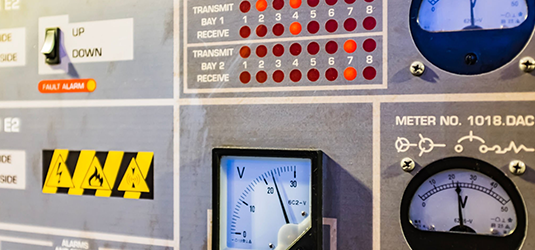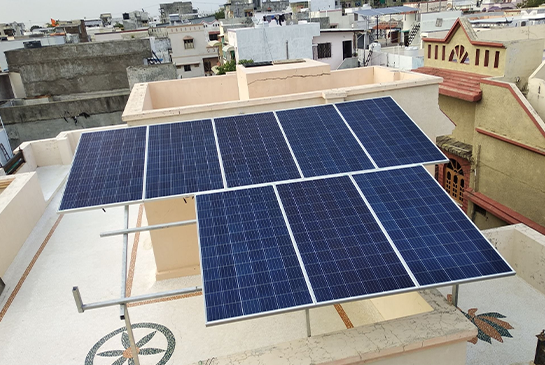On Grid Solar System
Harvest solar energy by installing an on-grid solar system on your house rooftop with a subsidy. We help you get tailored on-grid solar quotations from vetted DISCOM-registered installers. Compare quotes side by side and select the best one!
On-Grid Solar System
Using solar energy is a great way to harness the energy of the sun. Not only does it reduce the electricity cost but also works towards reducing use of carbon. This works towards decreasing pollution levels considerably. Using solar energy is a great way to harness the energy of the sun. Not only does it reduce the electricity cost but also works towards reducing use of carbon. This works towards decreasing pollution levels considerably. One of the most famous solar systems used these days is on-grid solar system. However, not many of us are quite clear about what on-grid solar system is. Let us get a clear understanding of on-grid solar systems.
What is an On Grid Solar System?
Also known as grid-tied, this type of solar system works along with the utility grid. This system lets consumers use solar energy as well as electricity from their grid connection. Direct current is generated from the solar panel which is then converted by the inverter into alternating current to be used for home appliances. The on-grid solar system comes along with a high-efficiency solar panel, solar inverter, mounting structure and other accessories. On-grid solar system does not require batteries therefore it is economical without recurring costs for replacing it.
Either you can use the power instantly or else it gets exported. The peak time for solar power generation is between 9:00 am and 3:00 PM. This time span is known as solar window. However, this duration depends on factors like type of solar panel, shadow etc. If you are planning to install an on-grid solar system in your home contact Das Energie Private Limited today. We offer products of some of the top brands in the country. Choose the best suited solar panels, inverters as well as all other components of the solar system from us today.
How Does On Grid Solar System Work
Generation of solar power in an on-grid solar system starts from the solar panel and goes through a number of steps. Let us check out how the system works with the help of the following steps
Step 1
The Solar Panel absorbs photons from sunlight and generation of electric energy begins. As soon as these photons are absorbed by the panel, free flow of electron begins. Aggressive vibration of electrons generates electricity which is in DC (direct current) format.
Step 2
Then the current travels through wires and passes through charge controllers and enters the solar inverter. Here the electricity is converted from DC to AC (Alternating Current). This is necessary because direct current cannot be used to operate appliances.
Step 3
After the requirement for home appliances is met, the remaining electricity is transferred to the utility grid. Though there is no battery needed for this solar system but the grid acts as its battery where all the excess energy is fed.
Step 4
At night when solar energy is absent, the grid transfers back the energy that was stored during the day. Even on cloudy days when power generation is less, the grid supplies the required electricity to meet your household requirements.
Step 5
At the end of the month the calculation of your bill will be done taking into consideration all the exports and imports of electricity with the help of a bidirectional metre.
How Does a Bidirectional Meter Work?
There are two types of metres, one is unidirectional and another is bidirectional. In case of a unidirectional metre, you can only view the total energy imported from the grid. While in case of a bidirectional metre, you can view the total energy imported, exported as well as net difference between imported and exported energy.


Net Metering On On-Grid Solar System
In case of on-grid solar system, there is an added advantage of selling the excess power back to the grid. This is possible because on-grid solar systems are connected to the utility grid. For this a bi-directional metre is required, as this will help in measuring power purchased and power returned. As there is absence of any type of battery for power storage in case of on-grid solar system an electricity connection is necessary with the grid. This will help in transferring unused energy as well as help on cloudy days when production of solar power is less. Net metering helps with saving solar power that would otherwise be wasted as there are no batteries to store. If you want to opt for an on-grid solar system, we at Das Energie Private Limited will provide all round services starting from installation of solar panels up to installation of net metering. Contact us for the smoothest installation of your on-grid solar system.
On Grid Solar System Components
As mentioned above an on-grid solar system primarily requires solar panel, solar inverter and mounting structure. Not only these but there are a number of other components that are crucial for proper functioning of on-grid solar system. Below is all that an on-grid solar system would require to function:
What are the Key Differences between On-Grid and Off-Grid Solar Systems?
On-grid solar system is connected to the utility grid’s network. However off-grid solar system is one that does not share any connection with the utility grid. Therefore whether it is a cloudy day or a sunny one, on-grid solar system users get covered by their utility company. This is however not the case for off-grid solar system, because as soon as the energy stored in the batteries get exhausted you do not get any additional support from the utility grid on cloudy days or if there is a malfunction. In case of on-grid solar system, if you generate excess energy, you will be able to revert it to the grid. In return, you can cash out the requisite amount for exporting the particular amount of energy that was excess. However, this cashout system is not available for off-grid solar system users. This is because net metering is not available for off-grid solar system users.
While on-grid solar system components do not include battery, for off-grid solar system battery is an important component. It might happen that the solar panels on your rooftop generate more energy than is required for the home appliances to run. Then in case of off-grid solar system, they can store this energy in the battery. As the on-grid solar system is connected to the utility grid therefore the cost of buying batteries for backup does not exist. However, an additional cost of battery backup is present in case of off-grid. Want to know more about off-grid solar systems? Check out our page on off-grid solar system to learn in detail about it.
Benefits of Using an On-Grid Solar System
There is huge number of benefits if you opt for on-grid solar system. Let us take a look at the benefits one by one
Low Electricity Bills
On-grid solar system is connected to the grid and consumes energy from it in case solar energy generated is not adequate. Therefore the users of on-grid solar system need to pay for the surplus electricity they consume from grid. However often excess energy might also be generated from the solar panel, which will be fed back to the grid. In this case, you get discount on your bill for the same proportion of excess energy you revert back throughout the month. At the end of the month, the bill is calculated with the help of the net difference between export and import of energy. This often results in a modest electricity bill if not zero.
Additional Source of Income
As on-grid solar system has a link with the grid therefore there is an opportunity to charge for the surplus electricity generated. Therefore on-grid solar system users can avail cost benefits for excess electricity generation in the form of reduced electricity bills.
Easy to Install
You can install on-grid system easily by yourself on your rooftop. Other than that installation of on-grid system in housing societies, government organisations, community centres, private institutions, commercial complexes etc. is also easy.
Easy Maintenance
On-grid solar system requires lesser number of components therefore maintenance costs are lesser. As there are no batteries required therefore there is neither any maintenance cost nor there is any cost for replacement. In comparison to off-grid solar systems, the lifespan of on-grid solar systems is longer.
Synchronise With Other Sources of Power
In case grid power is not available you can connect a diesel generator. This can be really helpful when there is a power cut or fault in the grid. You can synchronise on-grid solar systems with different power sources.
Better Efficiency
On-grid solar is connected to the utility and works in sync with it. You can run as many home appliances as you want as there is no limitation if you use on-grid solar system. In terms of efficiency as well, on-grid solar system is better than other solar systems. If you use a 1 kw on-grid system it can produce 5 kw power.
Opportunity for Savings
One of the best advantages of installing on-grid solar system is reduction in electricity bills. When there is high demand for electricity you can utilise solar power and save yourself from paying any peak demand charges. Other than that with the help of net metering, you end up paying lesser electricity bill.
Better Return On Investment
In comparison to all other types of solar systems, on-grid generates the highest amount of power. It is even the most cost-effective as well. Once the price of the solar system breaks even after 4 to 5 years you can get solar electricity at a nominal cost for the next 25 years. Due to reduction in the monthly bill and minimal maintenance cost, customers get around 25% to 35% return on investment. Therefore customers earn a good sum of money if they invest in on-grid solar system.
More Economical
On-grid solar system does not require batteries for storing excess power as the grid plays the role of batteries. Therefore grid-tied system is cheaper to install if we compare it with other solar systems.
Subsidies and Other Incentives
When you invest in an on-grid solar system, government offers subsidies along with many other incentives.
Increased Value of House
When you install an on-grid solar system in your house or business it increases the resale value of the property. As more people are shifting to solar power, it is better to look for a property that has a pre-installed solar system. This will save your time and effort for installing a solar system as well as offer you the benefits. If you wish to make the most of these benefits, you can contact Das Energie Private Limited today to get your on-grid solar system installed. We offer solar equipment of the best brands in India at a reasonable price.
On Grid Solar System Disadvantages
Before investing a huge sum of money in on-grid solar system, it is also important to take a look at the disadvantages of installing an on-grid solar system. Here are all the disadvantages that you can come across when it comes to using on-grid solar system
No Power Backup
As the on-grid solar system does not have any battery backup. Therefore there is no way of storing electricity for power cuts. Power cuts occur quite often in certain regions of India. Therefore this is quite a big issue.
Power Outages
Due to its dependency on the utility grid, on-grid solar system users do not get during power outages. Though this situation hardly occurs in urban areas, however storms, thunders or broken-down grid might cause it.
Upfront Cost
The cost of installation of on-grid solar system is the lowest if you compare it with other solar systems. However, if you calculate right from equipment to installation, the initial upfront cost is quite high for on-grid solar system. Though there are subsidies as well as other incentives available from the government. The cost is quite a lot for which you might have to check a few financing options and choose the best suited for yourself.
Suitability of House
In order to install solar panel system and generate adequate power to meet your requirements your house needs to be located in a sunny location with little shading. Other than that not all roof types are suitable for installing solar panels as this might hamper productivity.
Installation Process of On-Grid Solar System
Here are 6 easy steps as to how you can install on-grid solar system in your house or for any commercial purpose
You simply need to visit the website and submit your request. After this, you will receive the feasibility report within the next 7 to 10 days. For processing the approval, you need to provide certain details like your email id and mobile number and documents like electricity bill, Aadhaar card etc. The registration process is completely online and for this, you do not pay any fees.
In solar quotation, you will learn about bills of materials such as on-grid solar inverter, balance of systems such as earthing kit, lightning arrestor, panel stand, DC wire as well as other installation accessories. Solar quotations also include product price, delivery and installation charges.
The quotation will depend on the kW of on-grid solar system you wish to install.
We at Das Energie Private Limited offer hassle-free installation of on-grid solar systems. Contact us today for a smooth installation that too at reasonable prices.
Different Capacities of On-Grid Solar Systems Available in India
There are different capacities of on-grid solar system available for residential as well as commercial use. The most common ones used are 1kW, 2kW, 3kW, 5kW, 7.5kW, 10kW, 15kW, 25kW grid connected systems. Other than these there are various other capacity on-grid systems available as well in the market.
The Ministry of New and Renewal Energy of India has set a benchmark cost which is the lowest quoted project cost for different capacity rooftop solar systems. Other than that, there is the subsidy which further reduces the price of the solar setups further. We at Das Energie Private Limited offer on-grid solar systems of different capacities that are suitable for all types of home and commercial use. Contact us today to get your on-grid solar power system at the best price.
Subsidy Offered on On-Grid Solar System
Subsidy on solar systems works as an incentive for individuals and organisations who are investing in solar energy. Government offers subsidies for installation of solar panels to make it more affordable. It also further reduces the cost of energy and increases use of clean energy. There are many states of India that offer solar subsidy, one of which is West Bengal. The government of West Bengal offers 30% subsidy on the total cost of installation of solar panels. This is available for both residential and commercial installations. On average, the cost of installation of solar panel system in West Bengal is ₹50,000 to ₹2,00,000. With the added advantages of subsidies and incentives, this price can reduce further. Other than that a 30% subsidy is also available for net metering as well.
Das Energie Private Limited offer complete assistance for receiving subsidies on the on-grid solar system. Contact us and our sales representative will give you a detailed idea as to how you can go forward with it. Since pollution levels are already at its peak and the electric bills are robbing us, it is best to move to on-grid solar systems. On-grid solar system is beneficial as it reduces both the pollution as well as your electric bill. Other than that it is also not as complicated as off-grid or hybrid solar systems. Now that you are aware of all the advantages of opting for on-grid solar, you can contact us to speak to our solar consultants for free.
Frequently Asked Questions
As on-grid or grid-tied solar systems work in sync with the utility grid therefore there are no limitations in it. You can run any type of appliance in house whether it is a fan or AC or fridge. The calculation goes in this way that a 1 kW on-grid system can generate 5 kW of power.
To understand what capacity of solar system you require for your home you need to first know how much electricity you consume from the grid monthly. The main purpose of installing on-grid solar system is to reduce your electricity bill. Let us now understand what is your capacity requirement on the basis of daily usage of electricity:
- If your daily electricity requirement is between 0 to 5 units then you can install a 1 kW solar PV system. In this case, if the monthly bill is ₹10 per unit then you will need to pay anything between ₹o to ₹1500.
- Similarly, if your daily consumption is between 5 to 10 units you will need to install a 2 kW solar system. Keeping the estimated unit cost same your monthly bill will be something around ₹1,500 to ₹3,000.
In case your average daily electricity requirement is 50 to 125 units. You will require a 25 kW on-grid solar PV system. If the estimated unit price remains the same then your monthly bill be around ₹15,000 to ₹35,000.
A solar panel is a device that collects sunlight and converts it to electricity. It is a collection of photovoltaic cells that uses sun’s rays for generating electricity.
As is quite evident from the name, bifacial solar panels produce electricity from both sides. This type of solar panel generates electricity from both the front and back.
Transparent solar panels can be used as window panels which can receive direct heat from the sunlight and convert it into electricity.

Listen to What our Customers Have to Say







Our Trusted Clients
